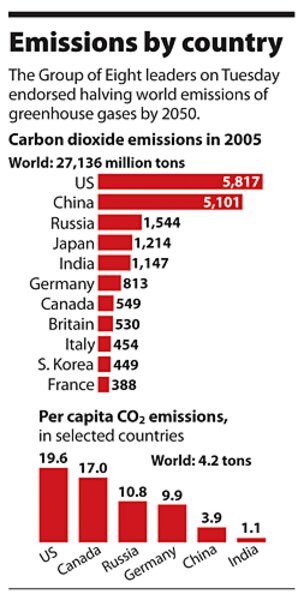On emissions, G-8 looks past Bush
Loading...
In Toyako, Japan, leaders of seven of the eight largest industrial nations issued a polite sayonara to President Bush this week and a message to the rest of the world: We’re likely to take a stronger, more specific joint stance on dealing with climate change next year, when a new US administration willing to take more-concerted action on the issue is in Washington.
That’s the assessment of several analysts parsing the climate provisions that the Group of Eight leaders unveiled Tuesday at their annual meeting. In the end, the group’s communiqué may be more important as a signal or restatement of negotiation positions within United Nations climate talks, rather than a significant blueprint for action on its own.
The group agreed “to consider and adopt ... at least a 50 percent reduction” of global greenhouse-gas emissions by 2050 via UN-sponsored talks. That put the outgoing Bush administration on record as supporting a target in more than an aspirational way. For now, however, those cuts would be measured against today’s emission levels, rather than the 1990 emission levels under the 1992 UN Framework Convention on Climate Change and its 1997 Kyoto Protocol.
The G-8 provisions lack specific interim commitments that the European Union has sought – and that developing countries say would represent the good-faith signal they need to join an international emissions-control effort.
“The G-8 is more useful as a benchmark of the stances that are going to be taken in other processes by some of its members,” says Robert Bradley, who heads the World Resources Institute’s international climate policy initiative in Washington. “The huge caveat is that its largest member will be changing commander in chief between now and the next meeting. People will be looking for early signs from an incoming administration that the US is changing course.”
Among the summit leaders, the communiqué represents a “new, shared vision” by the leading industrial economies in support of a new UN climate agreement. Negotiators hope to have it ready for approval at global climate talks in Copenhagen, Denmark, scheduled for the end of November 2009. In a statement at the G-8 meeting, European Commission President José Manuel Barroso called the climate provisions a “strong signal to the world” that industrial countries are serious about dealing with climate change.
The goal of at least 50 percent cuts by 2050 at least sets the boundary on discussions over emissions targets in a new agreement, acknowledges Phil Clapp, deputy managing director of the Pew Environment Group in Washington. “If you actually establish the 50 percent by 2050” as a target, “that would at least give you a number for the entire world to start subtracting from. Then it becomes an argument over who does how much.”
But, he adds, the science has signaled that strong steps need to be taken in the next 10 to 15 years if that longer-term goal is to be achieved. The EU already has set an interim target of reducing carbon-dioxide emissions to 20 percent below 1990 levels by 2020. More broadly, the Bali Road Map points to a need for between 25 and 40 percent cuts in CO2 emissions by then.
Unless industrial countries commit to a specific, binding interim target range, developing countries won’t sign off on the longer-term goal.
Such interim targets “are an essential step to unlock the waiting game,” says Peter Frumhoff, director of science and policy for the Union of Concerned Scientists.
Even then, the goals may not be aggressive enough. Over the past several months, James Hansen, with the National Aeronautics and Space Administration’s Goddard Institute for Space Studies in New York, has been arguing that to avoid the most destabilizing effects of global warming, atmospheric concentrations of CO2 must be cut far lower than the levels UN negotiators are discussing. To stand an even chance of holding warming to no more than 2 degrees C (3.6 degrees F.) by century’s end, UN negotiators are talking about stabilizing atmospheric CO2 levels at 450 parts per million. To avoid dangerous climate tipping points, Dr. Hansen now argues, the world should be aiming at 350 p.p.m. or less. Today’s level stands at about 385 p.p.m.
Meanwhile, during an interview appearing in the latest issue of Prospect Magazine, published in Britain, economist Lord Stern acknowledges that his controversial 2006 report on the economics of climate-change mitigation probably underestimated the cost and difficulty of dealing with global warming. The reasons: The economics studies his über-report relied on underestimated growth in greenhouse-gas emissions so far this decade, and they overestimated the oceans’ capacity to scrub CO2 from the atmosphere.
Indeed, the G-8 results suggest “that the political process is still well behind the science in terms of stepping up to the issue at the scale needed,” Mr. Bradley of the World Resources Institute says, at least at the international level.
That could change with a new administration and sufficient support in Congress. In the US, “there is a much greater cross section of public and political support for action” on climate change, says Dr. Frumhoff, noting that such support is far greater today than in 1992 or 1997.
Still, he adds, “we don’t have many more bites at this apple,” given that the costs of mitigation rise with time as greenhouse gases continue to build in the atmosphere. As a result, “there is a lot of hope pinned on the next administration, particularly the first year to 18 months, to give this a very high priority, given the Copenhagen process and the urgency of reducing emissions.”
Material from the wire services were used in this report.






